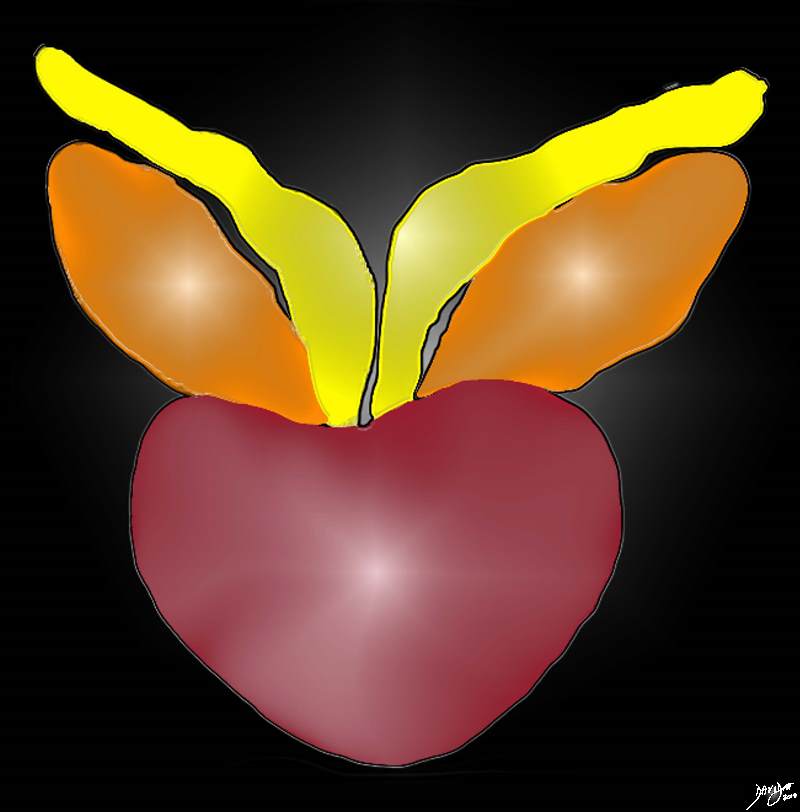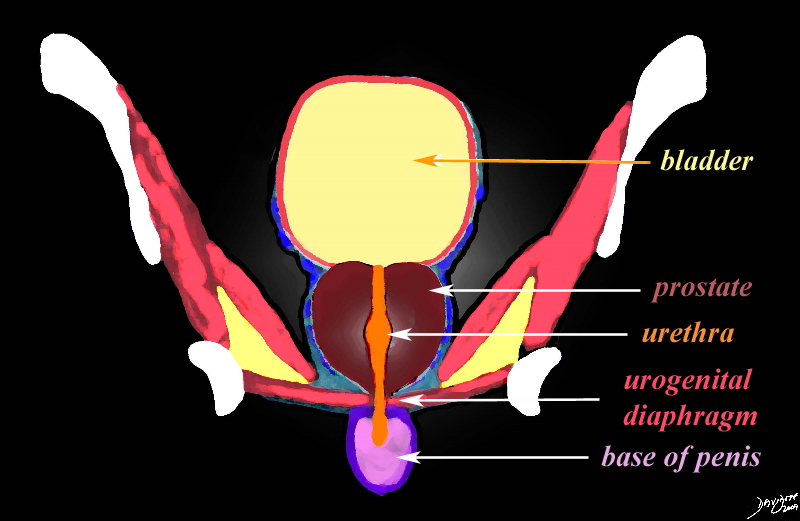The Common Vein Copyright 2010
Introduction
The prostate is rather unique among exocrine glands since it is the only exocrine gland that occupies a symmetrical central location in the body. The pancreas has both endocrine and exocrine function and is centrally placed, but its parts are eccentrically positioned with less of the gland on the right and more of the gland on the left side of the body.
|
Frontal View of the Prostate Central Position between the Bladder and the Penis |
|
The diagram reflects the basic anatomy of the chestnut shaped prostate lying in the deep pelvis between the bladder above and the urogenital diaphragm below and surrounded by the obturator internus and levator ani muscles and the inferior aspect of the ischium and pubic bones. The prostatic urethra runs through the prostate and connects the bladder with the penile urethra. Courtesy Ashley Davidoff Copyright 2010 99651b04.81Ls |
If one were to show the non inquisitive person the prostate gland of a bull, he or she might ask – “What is that?” The easiest answer would be – “It is a bull’s prostate,” and that could suffice as an answer. If on the other hand the same prostate was shown to a curious minded, or analytically minded person, they may counter with “How do you know?” or “Why is it a prostate?” The answer, based on the knowledge of the structure would include describing its unique and characteristic size, shape, position, and character. We may also speak to its parts, and its relationships to other structures its connections to other biological structures, how it changes with time and different cyclical events. The manner with which it functions in vivo would be its physiological characteristics.
The descriptors we used above are universal descriptors that can be applied to all biological structures whether it is the bull’s prostate, the glial cell of the brain or the pancreas of a mountain rat. We can use these descriptors to describe the cell, a tissue, an organ in both health and disease. We can also use these descriptors for clinical findings such as an enlarged prostate felt on transrectal examination that feels hard, nodular, soft, or rubbery.
The prostate is the only exocrine gland that occupies a central location in the body.
The size of prostate does not allow it to store large amounts of secretions.
The chestnut shaped form and position of the prostate has rational design. It is cradled by the urinary bladder, and fits snugly between it and the urethra. Giving passage to the urinary contents, and storing its secretions for the passage of semen through the same pathway.
The character of the prostate is based on its fel on palpation.

The Normal Cone Shaped Prostate and Other Accessory Sex Organs |
|
The artistic rendition of the normal prostate shows the cone shaped gland in maroon with the ductus deferens (yellow) and seminal vesicles. The prostate is about the size of a kiwi fruit and together with the seminal vesicles produce an alkaline fluid to protect the sperm from the relatively acidic environment of the vagina. The sperm are transported from the testes via the vasa deferentia to the ejaculatory ducts which enter the urethra and combine with the secretions of the two accessory sexual organs Courtesy Ashley Davidoff MD Copyright 2010 99380b02.8s |
The connections of the prostate to the rest of the gastrointestinal tract are via the seminerferous ducts. Its blood supply is via the cystic artery, venous drainage via the cystic veins, and lymphatics via hepatic system. Parasympathetic and sympathetic systems connect it to the autonomic system, while the hormonal control is via dihydrotestosterone (DHT)
The parts of the prostate include the central, peripheral and transition zones. It has a fibromuscular capsule surrounding it on all sides.
It appears morphologically simple on the outside but is complex internally at both the macroscopic and microscopic levels. The current concepts of its morphology have only evolved since 1968 after the work of McNeal. He suggested that the prostate was composed of three concentric zones that surround the prostatic urethra, and a fourth anterior zone.
In the 19th century the prostate was seen as having 4 lobes; 2 lateral lobes, a middle lobe and an inconstant anterior lobe. In 1912 an inconstant posterior lobe was added by Lowsley. Previously it was conceptualized as being composed of lobes.
Zonal concepts evolved with the work of
Three Concentric Zones
The peripheral zone (70%)
The central zone (25%) of the central volume.
The transition zone
Most prostate cancers originate in the peripheral zone. (prostatic intraepithelial neoplasia) and carcinoma.
The prostatic urethra bends halfway along its course through the prostate, creating two limbs of approximately the same length.
The prostate normally measures 3 cm in length, 4 cm in width, and 2 cm in depth.
Although ovoid, the prostate is referred to as having anterior, posterior, and lateral surfaces, with a narrowed apex inferiorly and a broad base superiorly that is contiguous with the base of the bladder.
The prostate lies within a capsule composed of collagen, elastin, and smooth muscle.
|
Zonal Anatomy of the Prostate in Transverse Plane |
|
The prostate gland can be viewed as having 4 major zones. In the young adult male the outer zone called the peripheral zone, accounts for 70% of the parenchyma. Inward of the peripheral zone is the central zone that accounts for 25% of the parenchyma. The periurethral zone is called the transitional zone and fibromuscular layer i(anterior layer account for the remaining 5% of parenchyma Courtesy Ashley Davidoff MD Copyright 2010 25078b04b02L05L.8s |


